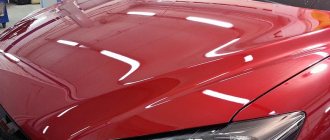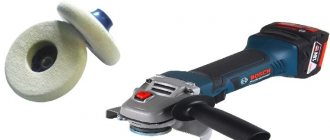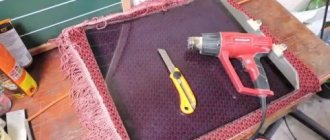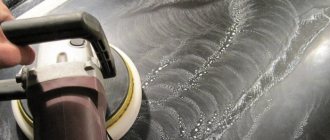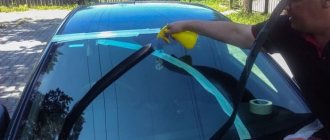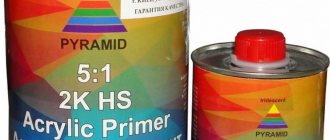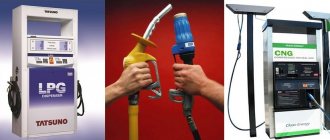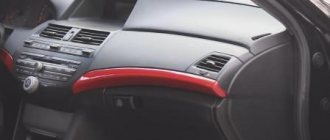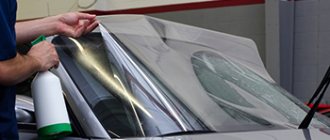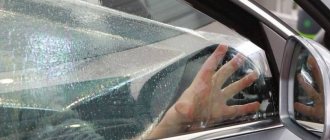No matter how much a car enthusiast protects his iron friend, defects and various scratches will inevitably appear on the windshield. The appearance of such lesions is due to the influence of an aggressive environment or due to mild mechanical influences. Depending on the depth of damage, defects can be divided into three categories: small, medium and large. Glass polishing paste will help eliminate them.
Damage options
In the first two to three years of operation of the car, the first minor defects begin to appear on the windshield of the car in the form of small scratches and chips no more than 200 micrometers deep. Often such damage occurs in the area of the wipers. Small scratches can be removed using a felt wheel and fine-grained paste. When polishing a windshield, a top layer about one micron thick is removed.
Defects with a depth of 200-300 microns are considered medium; such scratches are eliminated in several steps. During the first stage, correction is carried out with coarse-grained products based on zirconium dioxide and iron oxide. During the second stage, the final polishing of the car glass is done with fine-grained polishing pastes.
Scratches with a depth of more than 300 microns are considered deep. Their elimination is a rather complex and time-consuming procedure that requires the use of colorless photopolymer materials, and also requires coarse-grained polishing pastes based on chromium and cerium oxides.
When grinding a windshield, you cannot remove a layer of more than twenty micrometers. As a result of such improper processing, the glass becomes wavy and turns into something like a lens, and driving such a car is very dangerous.
First, repeated sanding is carried out with a coarse-grained polishing paste, then final polishing using a fine-grained paste.
Why is it necessary to polish the windshield?
The reasons leading to the need to polish the windshield are as follows:
- "Aging of glass";
- Wipers;
- Inaccurate washing of glasses or clearing them of ice;
- Crushed stone and gravel from under the wheels of cars ahead.
Glass aging does not occur by itself; if a car sits in a hangar for 20 years, its glass will not become cloudier than when it left the factory assembly line. Aging is conventionally called the invisible process of exposure of the windshield to fine abrasives in the form of dust and sand. The windshield acts as a wind shield; it saves passengers and the driver from a mass of dust particles, grains of sand, pebbles and insects. This process is similar to the effects of sandblasting; it is not surprising that over time the optical qualities of auto glass become worse. Any objects can leave marks; the longer we use the car, the more damage occurs to the windshield.
Wipers exist to quickly clean glass from water, snow and dirt; on the other hand, during operation they cause microscopic scratches. In order to reduce damage from friction, it is necessary to use windshield washer fluid.
The car enthusiast himself can often scratch the glass, clearing it of snow, ice and dirt. Dust, sand and dirt can cause minor damage to the glass when they fall on a rag or brush. At first it is completely unnoticeable, but then the scratches become more numerous and the glass becomes cloudy.
Crushed stone has a bad reputation among car enthusiasts; flying out from under the wheels of the car driving in front, it can make a noticeable crack in the windshield or, in case of great misfortune, break it.
All these reasons lead to the need to polish car windows, which means additional costs of time and money.
Differences between grinding and polishing
In case of significant damage, a grinding procedure is performed. For independent use, this is a rather complicated process, since grinding is done with an emery wheel using an abrasive material. In the absence of experience, it is better to entrust this work to professionals.
In case of minor damage to the car glass, it will be enough to carry out the polishing procedure, which is performed using a special paste; mechanical processing is minimal.
How to choose pasta?
Not every paste is suitable for polishing a windshield; when choosing it, you should give preference to a fine abrasive that will most likely not scratch the surface. One such product is 3M paste. The new product must first be tested on any suitable surface, and only then proceed with the polishing procedure.
Paste 3M 60150
This abrasive paste is designed to eliminate defects on silicate car glass. Main purpose:
- polishing minor scratches;
- removal of plaque and acid stains.
3M polishing paste is a creamy, white, water-based product that does not contain ammonium or silicone. The abrasive element is cerium oxide.
Mode of application:
- Prepare the surface - it must be cleaned with glass cleaner.
- Moisten a felt circle with water, then evenly apply two dessert spoons of 3M paste onto it.
- Wait until the polishing paste is absorbed and begin the polishing procedure. The speed of the machine should be 1200 rpm. You should remember to moisten the surface and periodically wet the felt circle on the back side.
- After completing the procedure, it is necessary to remove the remaining paste from the polished glass.
Useful qualities of polishes
Correctly selected and used according to the instructions, car glass polish will get rid of cracks and scratches and add shine. Proper use of the product is the key to maintaining the effect for a long time. Using windshield polish you can put it in order and provide the driver with a clear, clear view and traffic safety for a long time.
Polished car windows do not need frequent washing, which means that sponges and rags will leave fewer marks in the form of scratches and abrasions. Auto glass polishes provide protection from the harmful effects of ultraviolet radiation and aggressive substances (acid rain, bird droppings, liquid shampoo at a car wash). The protective film neutralizes the negative impact on the condition of the glass from pebbles flying while driving, dust and sand, and the movements of old windshield wipers.
With proper selection, application and compliance with the terms of use, the polishing agent will demonstrate all its useful capabilities. In this case, the polish can become a kind of insurance for car glass.
Water in glass polishing
When polishing a car's windshield, it is necessary to cool the surface with cold water in a timely manner. Clean tap water with a few drops of glass cleaning liquid is best.
Such a composition will simultaneously serve a dual purpose: to promote the polishing process and prevent heating of the polished surface. In this case, the glass should be only slightly wetted; a large amount of water will lead to hydroplaning.
The polishing procedure at home will take 3-4 hours, and will also require maximum patience. Polishing a windshield with paste will be much slower than polishing with 3TM wheels. But this procedure does not require additional surface cleaning. Polishing products will fall directly from the glass being polished into the polishing disc, which will prevent new scratches from appearing on the car glass.
DIY glass polish
You can do without buying expensive abrasive polish by preparing it yourself from inexpensive ingredients.
Paste GOI
You can use GOI paste with the required number (from 1 to 4). The paste is finely ground in a metal jar, and sunflower oil is added to it.
The mixture is heated over low heat until smooth.
Cerium oxide
A good option is cerium oxide with a fraction of 0.8 microns. It is diluted to a paste-like consistency with plain water.
Toothpaste
You can get by with the most affordable remedy - toothpaste. But only varieties with a whitening effect are suitable.
The effectiveness of such a polish is insignificant; it is only suitable for removing very minor defects.
Manicure polish
A deep scratch can be masked using clear nail polish.
It is carefully applied with a needle so that the liquid fills the gap and is allowed to dry. Excess substance is removed with an eraser or rubber spatula.
But keep in mind that the refractive index of light in varnish is different from that of glass. Therefore, when sunlight hits a place with a crack, it becomes noticeable.
Preparatory stages of polishing
Before polishing, be sure to wash the car and inspect the workplace to prevent various small particles from getting onto the surface. Such carelessness can lead to deeper scratches during operation.
You must first protect the car from polishing paste by covering it with film. It is better to outline matte scratches and stains on the back side with a marker, this will make them easier to find during polishing.
Recommendations for polishing at home:
- during work, prevent small foreign particles from getting under the polishing wheel;
- polishing is carried out using uniform circular movements;
- you cannot stop at one area, as you can change the optics of the glass and create a lens effect;
- the movements of the grinding machine should be smooth, soft, and careful;
- it is necessary to constantly ensure that the surface being polished is sufficiently moistened;
- do not allow sections to be missed.
Diamond pastes
Diamond paste, which also comes in different grain sizes, is effective for polishing glass. You can apply it to the surface using felt cloth or a felt circle. Diamond paste is used from coarse to fine, and for each subsequent type, take a new fabric. According to GOST, such a product is divided into several types:
- coarse diamond paste (red);
- medium, usually green;
- blue diamond paste – fine-grained;
- thin yellow;
- white diamond - the smallest, for finishing.
This paste consists of diamond powder and binding components. There is also a lilac paste, it is the most coarse-grained, that is, the size of the diamond chips in it is the largest. It is usually used for rough finishing. In addition, diamond paste can be hard or soft.
Abrasive pastes for glass car parts
Do not use diamond paste with your own hands, as this element is difficult to use even for specialists. You can very easily damage the protective layer by going too deep. The problem is that diamond paste quite easily destroys the protective film on the glass. If you are using a non-original part, then such polishing will ruin it. There are the following options for difficult cases:
- GOI paste is a universal material that is also used for glass products;
- materials similar in composition and properties to GOI paste, repeating its characteristics;
- special bars of products for the manual polishing process, designed for cars;
- special branded polishing mixtures and products for these operating options.
You can buy a can of polish at the store for manual or automated polishing. In this case, it is better to choose an expensive paste that has a number of positive reviews. Interestingly, GOI paste is very easy to use, and it can really help fix even quite serious damage to the surface of transparent parts of your car.
Finishing polishing mixtures for glass surface shine
If polishing is carried out to achieve a more shiny and glossy surface, then it is not necessary to use any abrasive materials or expensive special products. The surface must be prepared by thorough washing to avoid damage by dust and other small particles. All this makes it quite easy to process and get the desired result.
Choose standard pastes that do not penetrate too deeply into the protective film. Otherwise, after polishing work, the surface may become very dark and dull. This will cause some problems with the review. This is especially true for the glass of VAZ and other domestic cars. Polishing such a product can be dangerous, so all actions must be performed with caution.
